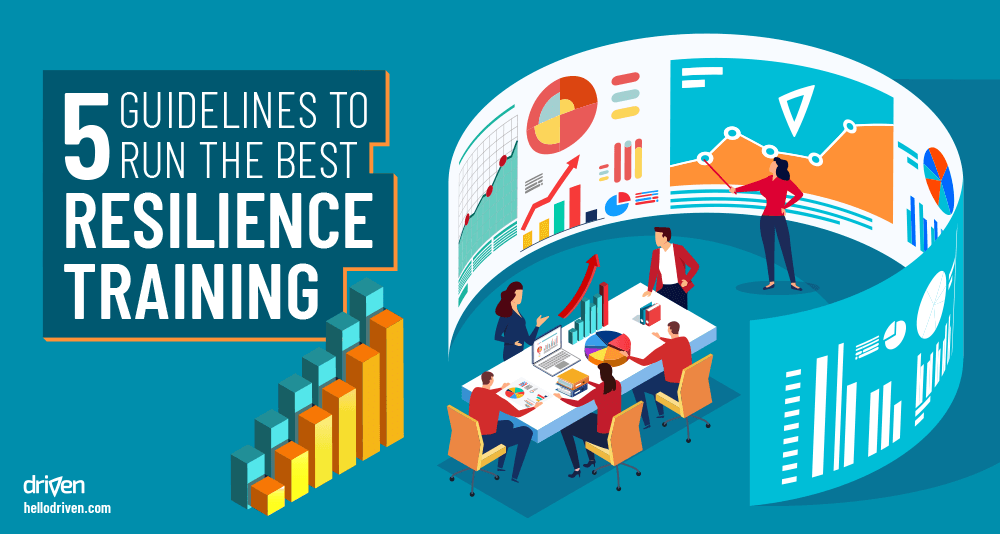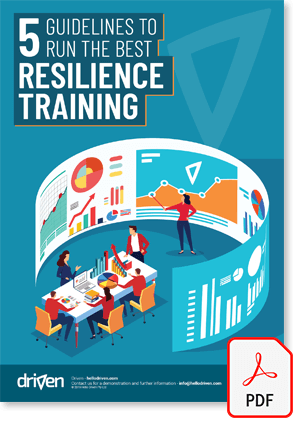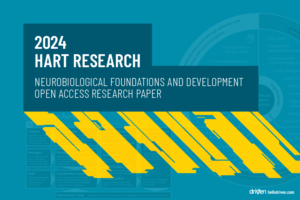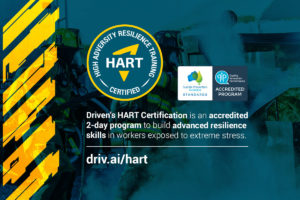Running a workplace resilience training program is high on the agenda for many top organisations. More and more we hear from businesses who recognise the benefit of building a resilient workforce. After all, here are some of the quantifiable benefits of resilient people we have seen through our research:
$6,152 annual per employee saving through investing in a resilience program
83% higher job satisfaction for staff with high resilience
43% less likely to leave – drastically improved retention
1.8 fewer days in sick leave – improved absenteeism through better health
2.1 fewer days lost to presenteeism
4% improved performance
Explore our resilience in the workplace training.
These numbers are important for business, though achieving this is not always as easy as it seems. What is resilience training? A resilience program needs the right components and launch to be successful and be received positively by staff. With this challenge in mind, here are five guidelines we have found to run a successful resilience program.

Guideline 1 - Measure resilience growth
Far too many resilience programs run without measurement, leaving management with no idea if the investment was worth it. Even worse, so often ineffective programs permeate through large businesses just because others have used it. To make sure your investment is worthwhile, and also that you are doing the best for your people, it is crucial to measure data points. In particular:
What’s the starting point?
It’s important to know where you are starting from. After all, how will you be able to judge if the program works if you don’t know where you are starting from?
Doing an initial assessment also gives you immediate value. You can benchmark to see where you are compared to other organisations, plus you can see at a team level where there are strengths and areas for improvement. Here it is important to ensure staff confidentiality, making it clear that no individual results will be accessible through the company itself, which is where an external facilitator is often the best path.
The type of the assessment used should only be validated psychometrics that are proven to measure the right factors. Validation means that the assessment tool has been scientifically proven and peer-reviewed, giving you assurance that you are getting a true snapshot of your people.
What are the priorities?
Measurement is not just about knowing where you are at, but also what are the key priorities within the organisation. A holistic resilience assessment will tell you what people are really struggling with – is it stress, uncertainty about progression, lack of support, lack of sleep, not enough time to exercise, lack of access to resource, or something else?
Equipping staff with skills to build better personal relationships have a real benefit that flows through to the workplace.
Becoming aware of these priority areas across different departments help inform internal program choice and policy to fine tune different management practices. In addition, giving teams access to their own aggregated reports allow interesting internal discussions that we have often seen result in greater team cohesion and collective ownership of actions. This fosters long term participation and lasting change.
Individual awareness matters
An incredibly useful aspect of performing a pre-assessment is to help individuals become more aware of their own level of resilience. Quite often, people feel they don’t need to learn about resilience, but once they complete an assessment and get their own report, it suddenly becomes clear why life is not as good as it can be.
This awareness is what spurs many into action, now knowing there are skills and knowledge they can build that will help them be more successful and satisfied in life, and that they can track their progress along the way.
How are we progressing?
The outcome measure of many resilience programs is a feedback form to check if participants enjoyed the training. I’d like to really stress that this is not a sufficient way to test program effectiveness!
Just because people had fun doesn’t mean they learned anything. It doesn’t mean you achieved any behavioural change that truly helps people live better lives.
Using a validated measure to check in on company-wide resilience is the only real way to confirm progress. This assessment can then be cross-validated with other measures such as retention, absenteeism, and performance as proof that the investment made a tangible difference.
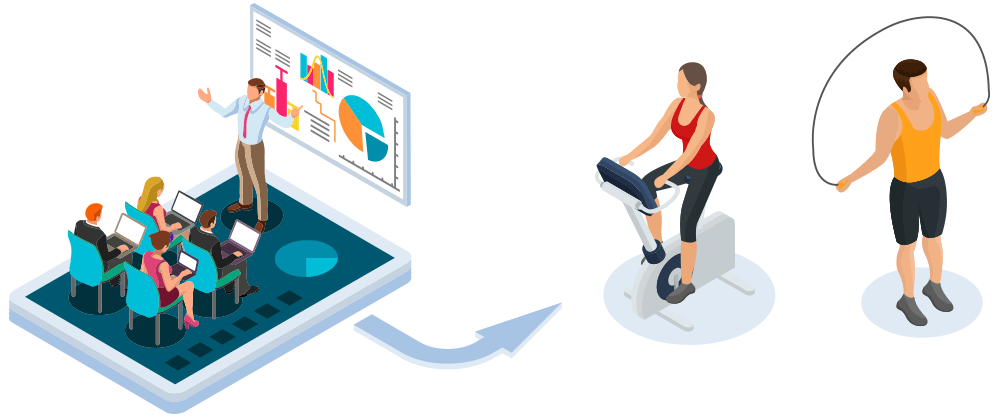
Guideline 2 – Focus on human benefits
Talking about performance, I should point out that workplace resilience is often misunderstood. Sometimes it is perceived as telling staff to ‘toughen up’ and improve performance – though resilience is so much more than that. When implementing a resilience training program, it’s important to focus on the true benefits that increased resilience brings. These go well beyond benefits to the business.
Stronger relationships through resilience
From friendships, to colleagues, to marriages, resilience helps people build strong and lasting relationships. As we have all experienced, conflict is a natural part of relationships, and being able to take those in our stride, not overreacting, and resolving conflict respectfully makes a big difference.
Especially in recent times, research shows us that people have less close friends than ever, despite relationships being shown as the most important contributor to a good life. Following this realisation, equipping staff with skills to build better personal relationships have a real benefit that flows through to the workplace. After all, if people are happier at home, then there is less to distract their focus the rest of the time.
Reverse depression and anxiety through resilience
The global decline in mental health is one of the biggest challenges facing businesses, as organisations feel the direct effects of this trend. Just look at the numbers – over 300 million people have depression worldwide, with more than 260 million suffering from anxiety. There are over 800,000 suicides worldwide. And these are just some of the ‘big’ statistics.
Resilience is proven to improve mental health, having been highlighted by researchers as a key option to address depression and other disorders (Elisei, Sciarma, Verdolini, & Anastasi, 2013).
If managers are not leading by example and using wellness programs themselves, then staff will not use it either.
Many businesses have reactive measures in place, such as EAP services for the really tough situations. But shouldn’t we really be looking to help people proactively? Preventative intervention is what really drives change in the long term. This is where resilience truly shines – a preventative skillset that helps people avoid challenges down the track.
Resilience improves wellbeing
Wellbeing includes good health, happiness and satisfaction with life. These are the outcomes that we all want for ourselves and our employees. So how do we reach this? We achieve wellbeing through learning and employing the various resilience skills that lead the right action and mindset to thrive.
In short, wellbeing is what we want to achieve, while resilience is how we achieve it.
As organisations, we need to put the wellness of our employees first. Displaying true care for the wellness of employees can feel counter-intuitive since performance is really what is important to the business. However, given that employees are quick to leave when they feel an organisation doesn’t care about them, so the new enlightened path is the recognition that if you truly care about your employees, they will care about you. This is what translates into business measures, but it starts by truly caring about your people and their own wellness.
Boost work & life satisfaction
At work, resilience has an interesting effect. In our research, we noticed that for every 2% increase in resilience, employees experience a 1% increase in job satisfaction. This is interesting as two people in exactly the same job can have very different experiences of the work, simply because they have different resilience levels.
We also see that emotional resilience training adds to higher quality of life, meaning it’s definitely not just about work – resilience improves life satisfaction as well. This is why investing in resilience training for staff is such a fantastic initiative – it helps people in all areas of their lives, teaching the crucial life skills that are applicable in all scenarios where they might face adversity.
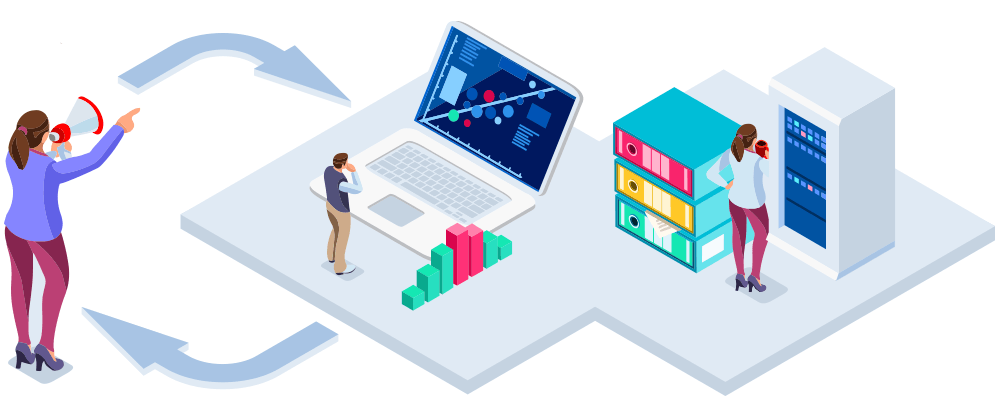
Guideline 3 - Management leads by example
Has your organisation tried to launch a new wellness program and saw low participation rates? Looking back, how was the program launched? Often the program launch leaves a lot to be desired, resulting in low participation and little appetite from executives to further invest. We often achieve around 89% participation in our programs – this is what we’ve seen work:
Middle management matters
Let’s start in the middle. Why? Because, believe it or not, middle managers contribute the most to program participation. Line staff look to managers to see if the program is something they should take seriously.
If managers are not leading by example and using wellness programs themselves, then staff will not use it either. The only participants you get in this scenario are those that are very proactive with their wellbeing, which often are not the people that most needs the program.
Reaching staff that needs the program the most is important, as that is where the true business and human benefit lies. And to achieve this, middle management needs to lead by example and show the team that it’s important to them, and that they want staff to use it too. So how do we get management engaged? Well, they look up to the leaders.
Leaders own the program
If leadership doesn’t show a clear commitment to the program to support it, then management won’t care about it either. Management will recognise it as a fad that will blow over and it won’t amount to anything.
We see programs truly succeed when leadership fully buys into the initiative, putting their commitment on display and making it personal as to why this is important, not just for the company, but also to them personally.
Connecting to the program on a personal level and communicating this message to staff is a great way to show that this is important, and everyone can benefit by participating.
Organisational commitment
Showing there is commitment and following through on what is said is what really gets things going. By doing measurement, leaders can also talk about how participation creates real change, as results from assessment will add into program choice for the wellbeing portfolio based on the needs of people. In effect, this democratises wellbeing programs within large organisations.
This is a tangible way to show that the organisation is committed to follow through, providing evidence that resilience is a mutual initiative – staff work on their own skills, and the business works on itself to improve alongside people.
Check in regularly
Once the program is underway, take opportunities to check back in with staff. This is very practical at the middle management level where check-ins can be scheduled alongside team meetings. These don’t have to be major events – instead, just a quick 5 minute chat on how people are progressing can be all that’s needed to keep momentum going.
The benefit here is that the program establishes a shared language, making it easier for team members to communicate about what’s happening. It also makes it easier for the team to establish collective tasks to help resolve shared concerns within the domains of resilience. Each team is different, so continuing this practice leads to great long-term participation and change.
At a company level, doing a refresh at on a 6-monthly basis is valuable; it allows for re-assessment to help individuals and the company as a whole track progress. Sometimes companies go through a tough period and this shows up in results, which is useful to know as a reminder to keep investing in the mental health of staff.

Guideline 4 - Make time for participation
You’d be amazed at how often companies launch wellness programs but don’t allow their staff to make time to participate. One of the toughest examples is call centres where time is tight and squeezing in time for a long training session is a big ask. Fortunately, program methodology changes bring new options to make it easier to find time.
Long seminars are out
How many interesting seminars have you been to, only to realise a week later that you’ve totally forgotten everything said at the event? This is extremely common, and I’ve personally seen this time and again in the corporate world. Yet the seminars persist, kept running by glowing feedback ratings that do not reflect any real change.
The challenge with seminars is also that they are hard to fit into the work day, requiring people to give up a lot of time that eats into productivity. Imagine a call centre having to find a free day – it doesn’t happen.
Scientific backing gives you that confidence to stick to the resilience program business case
Short brain-building microtasks are in
Quick resilience-building activities lasting about 5 minutes or less is a whole new approach to achieve change while also easily fitting it into the business day without disrupting normal flow. Taking this approach results in more neural pathway change through frequent practice, allowing new skills to be effectively embedded so that they can be used in the moment when facing adversity. This is great news, because not only is it better for helping people build resilience, but it also works better for businesses as it’s easy to fit 5 minutes into the day. For a program to be successful, people need to have the time to actually participate. Short activities make this easy. In fact, during a team meeting everyone can take five minutes to do their next activity. Easy and practical with measurable results.Encourage follow-through
As an organisation, it’s important to continually encourage people to take the time to invest in their own wellbeing. Notice the distinction here – it’s not about pushing them to participate in the program (i.e. it’s not about compliance). Rather, it is about encouraging staff to invest in themselves. Your resilience initiative is one avenue for them to do this. When encouraging follow-through, be sure to avoid any perception that a program is mandatory. If there’s a sense that participation is not their choice, then you will get participation without behavioural change. This will show up in analytics down the track as you see participation is high, but there are no measurable results across any other measures. Encouraging staff to take the time and invest in themselves again come from leading by example and having management show how they do it, providing role models for staff. And a key aspect to this is showing people how even management make the time to look after themselves. This is where staff will take their cues to improve their own lives.
Guideline 5 - Use science-backed training
It’s time to upgrade your resilience training. There has been a lot of advancement in the science and technology of building resilience, meaning you can now provide much better tools for your staff than ever before. Here’s what to look for:
Science-based, no feel-good fluff
There’s so much misinformation out there about health and wellness that we can no longer afford to supply resilience programs to staff without due diligence on the science. The reality is programs are not equally valid and effective, and programs lacking in scientific backing may actually harm your staff. We need to separate the feel-good fluff from what is empirically effective.
Resilience building activities should be built on proven science, ideally with a solid foundation of neuroscience combined with physical wellness. Peer-reviewed validation of tools used is a good indication that the program can truly help your staff.
And let’s be real, no one builds resilience in just one day. It’s a process that requires habit change and new mindsets to be forged. This means you need to stick with a program for it to really help your people, and you will need to be confident in the program to stick with it. Scientific backing gives you that confidence to stick to the resilience program business case and be, well, resilient in following through!
Proven to get participation
With your science-backed resilience training in hand, next you need to ensure the program can get you good participation. Few things are more disenchanting in HR than when a new program is launched, and participation rates are around 20%. An innovative program using the latest in engagement techniques with real personalised benefits to individuals will get you far better participation.
Here, participation is a combination of the innovativeness of the program, leadership support, and middle management promoting it on the ground and leading by example. We have seen this trifecta achieve lasting engagement with high completion rates and participation rates of 89% in large organisations. When was the last time you saw participation like that? Not even business engagement surveys get to these levels, though there’s a secret about that which I’d be happy to talk about separately.
Incorporating new technologies such as artificial intelligence for emotional resilience training and new engagement techniques can also help to get deeper engagement from younger staff who feel much more comfortable and connected through technology. This provides a pathway to scalability.
Scalable and efficient
Ongoing in-person training is fantastic. Unfortunately, costs are prohibitively expensive, especially when you have a lot of staff to cover. This is a key point as well – you’ll get the largest benefit if you provide resilience training at all levels, from line staff all the way up to executives. It’s here where many organisations go wrong – providing resilience training only to executives, top managers and high performers.
I’ve often heard from people at executive levels that the resilience training that they received would be have been far more valuable earlier in their careers. That’s why a workplace resilience training program that is scalable and able to reach all staff is what is best for meaningful and measurable organisational change.
Better technology means you can deploy organisational resources more efficiently, resulting in a higher return on investment. Businesses being business, if you can show better ROI, then it quite plainly helps with building and maintaining a business case for resilience training. While being efficient with finances is important, take care not to skimp on the human communication aspects that drive engagement.
An integrated resilience program
Over my years in the corporate world, I have seen many different types of programs with none ticking all the boxes. This was the inspiration that lead to the development of Driven as the best resilience training tool for the workplace, incorporating all these guidelines.
Ultimately what really makes a difference in the business world is for a resilience program to include validated measurements, and innovative training to be scalable and reach large groups in a meaningful way. This is what leads to results, not just for the organisation, but also at a human level that helps people live better lives.
We’re already working with many top organisations, top athletes, schools, government departments, psychologists, coaches, and more. If you’re interested in seeing how you can implement the best resilience training in mental health for your people, get in touch – info@hellodriven.com
All the best!
Jurie
